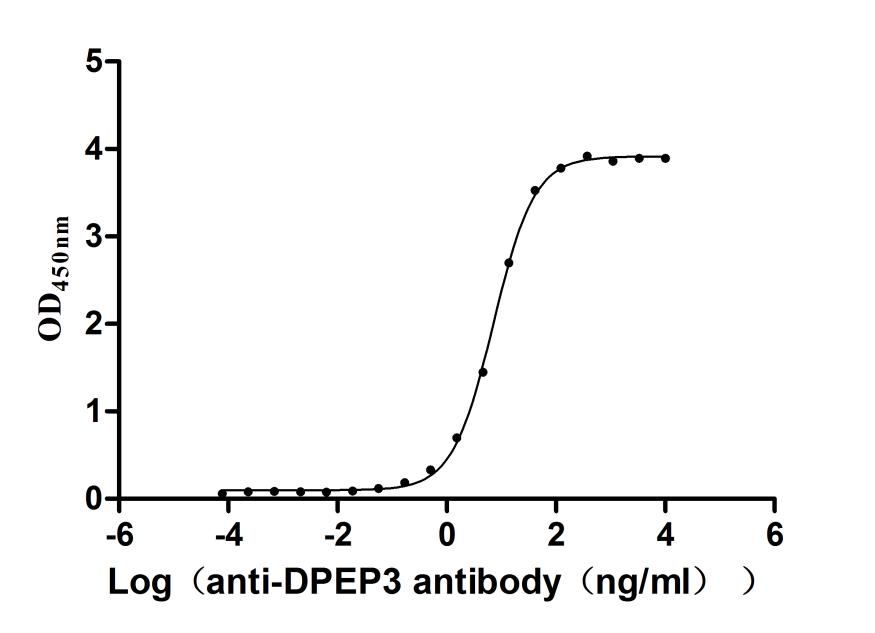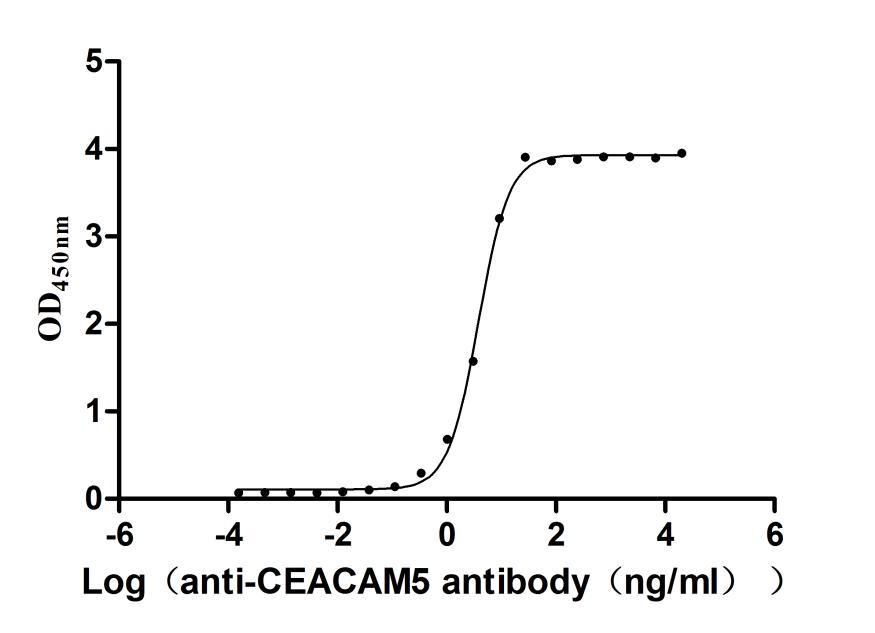Recombinant Mouse Epithelial cell adhesion molecule (Epcam), partial
-
货号:CSB-YP007717MO
-
规格:
-
来源:Yeast
-
其他:
-
货号:CSB-EP007717MO-B
-
规格:
-
来源:E.coli
-
共轭:Avi-tag Biotinylated
E. coli biotin ligase (BirA) is highly specific in covalently attaching biotin to the 15 amino acid AviTag peptide. This recombinant protein was biotinylated in vivo by AviTag-BirA technology, which method is BriA catalyzes amide linkage between the biotin and the specific lysine of the AviTag.
-
其他:
-
货号:CSB-BP007717MO
-
规格:
-
来源:Baculovirus
-
其他:
-
货号:CSB-MP007717MO
-
规格:
-
来源:Mammalian cell
-
其他:
产品详情
-
纯度:>85% (SDS-PAGE)
-
基因名:
-
Uniprot No.:
-
别名:Epcam; Tacstd1Epithelial cell adhesion molecule; Ep-CAM; Epithelial glycoprotein 314; EGP314; mEGP314; Protein 289A; Tumor-associated calcium signal transducer 1; CD antigen CD326
-
种属:Mus musculus (Mouse)
-
蛋白长度:Partial
-
蛋白标签:Tag type will be determined during the manufacturing process.
The tag type will be determined during production process. If you have specified tag type, please tell us and we will develop the specified tag preferentially. -
产品提供形式:Lyophilized powder
Note: We will preferentially ship the format that we have in stock, however, if you have any special requirement for the format, please remark your requirement when placing the order, we will prepare according to your demand. -
复溶:We recommend that this vial be briefly centrifuged prior to opening to bring the contents to the bottom. Please reconstitute protein in deionized sterile water to a concentration of 0.1-1.0 mg/mL.We recommend to add 5-50% of glycerol (final concentration) and aliquot for long-term storage at -20℃/-80℃. Our default final concentration of glycerol is 50%. Customers could use it as reference.
-
储存条件:Store at -20°C/-80°C upon receipt, aliquoting is necessary for mutiple use. Avoid repeated freeze-thaw cycles.
-
保质期:The shelf life is related to many factors, storage state, buffer ingredients, storage temperature and the stability of the protein itself.
Generally, the shelf life of liquid form is 6 months at -20°C/-80°C. The shelf life of lyophilized form is 12 months at -20°C/-80°C. -
货期:Delivery time may differ from different purchasing way or location, please kindly consult your local distributors for specific delivery time.Note: All of our proteins are default shipped with normal blue ice packs, if you request to ship with dry ice, please communicate with us in advance and extra fees will be charged.
-
注意事项:Repeated freezing and thawing is not recommended. Store working aliquots at 4°C for up to one week.
-
Datasheet :Please contact us to get it.
相关产品
靶点详情
-
功能:May act as a physical homophilic interaction molecule between intestinal epithelial cells (IECs) and intraepithelial lymphocytes (IELs) at the mucosal epithelium for providing immunological barrier as a first line of defense against mucosal infection. Plays a role in embryonic stem cells proliferation and differentiation. Up-regulates the expression of FABP5, MYC and cyclins A and E.
-
基因功能参考文献:
- The expression of Epcam mRNA, which is a functional marker of potential hepatic stem-like cells, was controlled by LEF1, which was regulated by CLOCK. PMID: 29958886
- EpEX/EpCAM are sufficient to reprogram fibroblasts into iPSCs with only Oct4 or Klf4. PMID: 28157205
- extracellular vesicles tend to localize in the intestinal tract associated with epithelial cell adhesion molecule PMID: 27721471
- Data show that EpCAM-expressing proliferating ductal cells (PDC) could be a cellular origin of hepatocellular carcinoma (HCC), suggesting the existence of stem/progenitor-derived hepatocarcinogenesis. PMID: 28951464
- activation of hepatic H19RNA promoted cholestatic liver fibrosis through the ZEB1/EpCAM signaling pathway PMID: 28407375
- These results identify EpCAM as a substrate of matriptase and link HAI-2, matriptase, EpCAM, and claudin-7 in a functionally important pathway that causes disease when it is dysregulated. PMID: 28094766
- EpCAM appears to differentially regulate Langerhans cell mobility/migration in the setting of limited inflammation as compared with the intense inflammation triggered by contact sensitizers PMID: 27106675
- Knock-down EpCAM cell model of congenital tufting enteropathy was developed. In vivo inducible mouse model was developed resulting in mutant EpCAM protein. PMID: 25482158
- in addition to converting to cholangiocyte-like cells, Sox9(+)EpCAM(-) cells provide luminal space near expanded ductular structures to prevent deterioration of the injuries and potentially supply new hepatocytes to repair damaged tissues PMID: 24482234
- EpCAM is a highly conserved protein present in fishes, amphibians, reptiles, birds, marsupials, and placental mammals, and is subject to shedding, gamma-secretase-dependent regulated intramembrane proteolysis, and proteasome-mediated degradation. PMID: 24009667
- Suggest pivotal role of EpCAM in intestinal epithelial structure and integrity, with mutations resulting in congenital tufting enteropathy. PMID: 24337010
- mTrop1/Epcam knockout mice develop congenital tufting enteropathy through dysregulation of intestinal E-cadherin/beta-catenin. PMID: 23209569
- EpCAM contributes to formation of intestinal barrier by recruiting claudins to cell-cell junctions. PMID: 22819673
- These results conclusively link EpCAM expression to Langerhan cell (LC) motility/migration and LC migration to immune regulation. PMID: 22411813
- Results show that SSCs are the most concentrated in CD9(+)EPCAM(low/-) population and also suggest that EPCAM plays an important role in progenitor cell amplification in the mouse spermatogenic system. PMID: 21858196
- EpCAM could contribute substantially to the pathogenesis of lung cancer. PMID: 21535318
- EpCAM was required for differentiation or survival of parietal trophoblast giant cells, normal development of the placental labyrinth and establishment of a competent maternal-fetal circulation. PMID: 20046825
- analysis of EpCAM expression in normal, non-pathological tissues PMID: 17981779
- The spatiotemporal expression pattern of EpCAM changes during nephrogenesis PMID: 18025791
- These data suggest that EpCAM is involved in signal transduction triggering several intracellular signalling pathways using tumor cell lines in colorectal and lung cancer. PMID: 19002182
- EpCAM(+) cells isolated from injured liver proliferate to form colonies in vitro, and the clonally expanded cells differentiate into hepatocytes and cholangiocytes, suggesting that the oval cell fraction contains potential HSCs. PMID: 19429791
- expression of EpCAM and DLK1 suggests the developmental pathways of mouse liver progenitors PMID: 19527784
显示更多
收起更多
-
亚细胞定位:Lateral cell membrane; Single-pass type I membrane protein. Cell junction, tight junction.
-
蛋白家族:EPCAM family
-
数据库链接:
KEGG: mmu:17075
STRING: 10090.ENSMUSP00000061935
UniGene: Mm.4259
Most popular with customers
-
Recombinant Human Nectin-4 (NECTIN4), partial (Active)
Express system: Mammalian cell
Species: Homo sapiens (Human)
-
Recombinant Macaca fascicularis Trophoblast glycoprotein (TPBG), partial (Active)
Express system: Mammalian cell
Species: Macaca fascicularis (Crab-eating macaque) (Cynomolgus monkey)
-
Recombinant Human Carcinoembryonic antigen-related cell adhesion molecule 6 (CEACAM6) (Active)
Express system: Mammalian cell
Species: Homo sapiens (Human)
-
Recombinant Human Tumor-associated calcium signal transducer 2 (TACSTD2), partial (Active)
Express system: Mammalian cell
Species: Homo sapiens (Human)
-
Recombinant Human Dipeptidase 3(DPEP3), partial (Active)
Express system: Mammalian cell
Species: Homo sapiens (Human)
-
Express system: Mammalian cell
Species: Macaca mulatta (Rhesus macaque)
-
Recombinant Human Interleukin-1 receptor accessory protein (IL1RAP), partial (Active)
Express system: Mammalian cell
Species: Homo sapiens (Human)



















